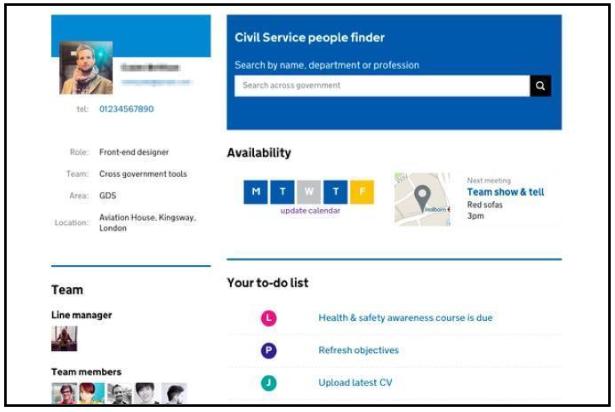Government Digital Service (GDS) Blogs
|
|
Civil servants are users too
Blog posted by: tephen Foreshew-Cain and Mayank Prakash, 28 September 2015 — Government as a Platform, People and skills

In some ways, the civil service is very different to corporate organisations. And in other ways, it’s very much the same.
Most of our time is spent building secure digital services for citizens starting from data. Just like people in almost any large organisation, civil servants have to go through induction and training courses, do performance management reviews, claim expenses, and sometimes move from one civil service job to another.
All of those things require a certain amount of management, which of course comes with inevitable paperwork. Right now, that management happens in lots of different ways. Sometimes it’s wrapped up in some sort of database or information management system, and other times it’s just documents that sit on people’s computers and get emailed from one person to the next.
Basic tasks like this shouldn’t be difficult or time-consuming, but at the moment they are.
It takes up much more time than it should. Civil servants, just like people in other sectors, should be able to focus on the work they were hired to do, and not spend hours and hours on the bureaucracy that surrounds it.
What is the user need?
In recent months, a small team based at GDS has been running a discovery, looking at the tools civil servants use to get all these tasks done.
They started with user needs, because civil servants are users too.
They talked to, listened to, and observed some civil servants in different roles and departments about their experiences of using various services to do things like apply for jobs, book meeting rooms and record training. They heard people’s frustrations, and developed an understanding of their needs. Then they started to build a prototype.
A cross-government platform for civil servants
Here’s a quick video overview of some of the features included in the cross-government services prototype:
It’s built as a platform: a common, shared technical infrastructure that can be used across government. That means departments can use different ways of meeting the needs of their users, while being confident their services will talk to other services in different departments.
It’s not designed to replace any of the large systems many departments depend on for complex interactions like payroll management, but it is designed to change how data is passed in and out of those systems to make them easier for civil servants to use.
It includes a personal data store for every civil servant - a digital space every individual can use to control what data they share, with whom, and how it’s updated. It could enable staff to share their work objectives (or not), their career history and specialist skills (or not), or their preferred forms of communication (or not).
That will make it easier not just to find the right contact details for someone, but also to find the right person to contact, wherever they are in the civil service.
Three collaborators, two workstreams, one goal
There’s a lot of work to be done to take this project further.
GDS isn’t looking to do everything - we can’t, and we don’t want to build everything centrally. So we’re working with others to take the next step fromdiscovery to alpha.
The Department for Work and Pensions (DWP) is hiring digital technologists and as we attract the best talent across the UK we want colleagues to experience an amazingly easy to use digital workplace. So DWP has decided to become the seed adopter of this alpha, with Technology users as the pilot user community. DWP and GDS will together build on everything that was uncovered in the discovery and make it better so that it can be used by colleagues across DWP and across all government departments
Civil Service Learning (CSL) is funding an additional programme of work focusing on ways to improve how civil servants do training and development, another vital part of every civil servant’s day-to-day work and another thing that would be improved through user-centric design. These changes will link up well with the big improvements CSL will be making to learning.
There will be two teams working collaboratively towards a single goal, made up of individuals from DWP, CSL and GDS, and working from both DWP and GDS offices.
This is great news. It’s exactly the kind of thing we mean when we talk about collaborative working between departments and the centre: it’s all about building the team and giving them time and space to think. Because together we can do more.
Join the conversation on Twitter, and don't forget to sign up for email alerts.
You may also be interested in:
- Learning and doing together
- Cambridge coding club for girls
- It’s not about us, it’s about collaboration


.gif)